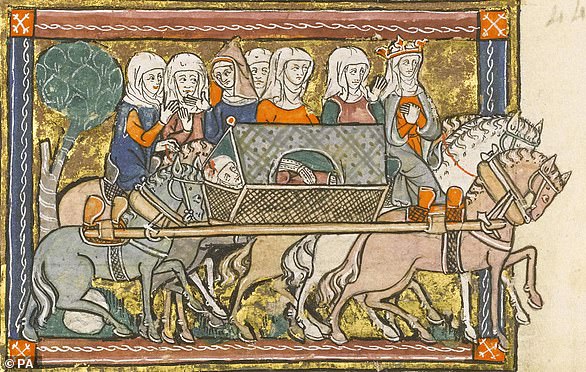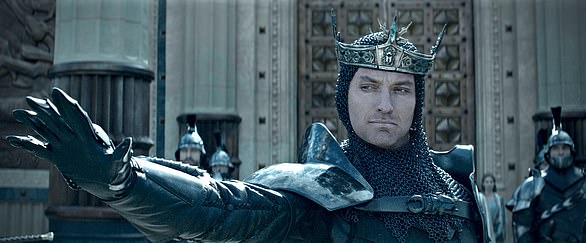The ambitious quest to find Excalibur: Divers are searching British lakes on a mission to locate the 'magical sword' thrown into the water by King Arthur
- Legendary sword is said to be thrown into waters by the king in the 6th century
- READ MORE: Experts start to excavate King Arthur's stone in Herefordshire
The mythical sword of Excalibur must be one of the most famous objects in history.
Owned by King Arthur, the legendary British leader of the 5th and 6th centuries, it was endowed with 'magical' powers that made him such a formidable warrior.
As the legend goes, it was thrown into a lake by King Arthur as he lay dying, following his final battle somewhere in Britain.
Now, experts are on an ambitious quest to locate the object in British waters – and they're not being deterred by the possibility it doesn't even exist.
They say they have identified several possible locations for Excalibur and are trying to find it for part of a new TV series called 'Weird Britain'.

The mythical sword of Excalibur must be one of the most famous objects in history (artist's impression). As the legend goes, it was thrown into a lake by King Arthur as he lay dying. Excalibur is also the name given to the sword in the stone drawn by Arthur as proof of his birthright and royalty, although but many sources insist that they were two different swords
A team of filmmakers, magnet fishers, tech experts, archaeologists and divers are part of the new quest to find Excalibur.
The first part of the project started in an undisclosed location in Cornwall last year, but more British waterways are set to be searched.
'We've not been beaten yet and nobody has the amount of equipment we have,' said Nigel Lamford, head of Northants Magnet Fishing, which is part of the project.
'If it's in there and it's magnetic, it's coming out.'
The experts believe there are several possible locations where Excalibur could be in Britain.
In Cornwall, it could be in Dozmary Pool, out on the edge of Bodmin Moor, or up near Alderley Edge in Cheshire.
The team hopes the project will either cement the sword's mythical status further – or unearth some big surprises.
'There is much debate about the location of the lake referred to in Arthurian lore,' said Tim Whittard, producer on Weird Britain.
'Identifying the lake in question is a riddle which has had historians and researchers arguing for centuries, that is if the lake even still exists – or if the legend is even true in the first place.'
For the search, experts are using underwater drones and remotely operated vehicles (ROVs) – unmanned machines that are controlled by staff from afar.

According to legend, the sword was located at a magical lake where the Lady of the Lake, a character of Arthurian legend, gave it to Arthur. Later, when the king lay mortally wounded after his last battle, he ordered the faithful Sir Bedivere to go to the water and throw the sword into it. An arm rose to catch it, brandished Excalibur three times, and then disappeared

A team of filmmakers, magnet fishers, tech experts and divers have embarked on an outrageous quest to find the magical sword called Excalibur

Experts have identified several possible locations for Excalibur in Britain and are trying to find it for part of a new TV series called 'Weird Britain'

King Arthur was a mythical king in the mythology of Great Britain. He lived in the medieval times, in his famous castle, Camelot. He possessed a sword known as Excalibur, given to him by the Lady of the Lake. Pictured: King Arthur by Charles Ernest Butler (1903)
ROVs are either tethered or untethered to a bigger surface vessel and operated using a joystick, almost like the controller of a gaming console.
'This is the first time we have had the opportunity to use underwater drones or submersible ROVs alongside professional magnet fishers in an expedition of this type,' said Mr Whittard.
'I think it's a really innovative and fun application of the drone technology which will make for great TV.'
As the legend goes, the sword originated at a magical lake where the Lady of the Lake, a character of Arthurian legend, gave it to the king.
Later, when the king lay mortally wounded after his last battle, he ordered the faithful Sir Bedivere to go to the water and throw the sword into it.
An arm rose to catch it, brandished Excalibur three times, and then disappeared.
This allegedly occurred at the mythical island of Avalon, which has connections with modern day Glastonbury in Somerset.
Arthur was taken to Avalon to recover following his final battle, the Battle of Camlann, which was possibly in Cornwall, near Hadrian's Wall in northern England, or even in Wales.
A Welsh document likely from the mid 10th century, called Annales Cambriae, records the date of Arthur's death at Camlann in AD537-9.

Excalibur (meaning to 'cut steel') was the great sword of King Arthur which 'gave light like 30 torches'. Pictured, Excalibur the sword by Howard Pyle (1903)

Underwater camera operators, drone experts and amphibious archaeologists have joined the hunt for the mythical sword

For the search, experts are using underwater drones and remotely operated vehicles (ROVs) - unmanned machines that are controlled by staff from afar

They say they have identified several possible locations of Excalibur in Britain and trying to find it for part of a new TV series called 'Weird Britain'
Excalibur is also the name given to the sword in the stone drawn by Arthur as proof of his birthright and royalty – the story that inspired the 1963 Disney cartoon film – but many sources insist that they were two different swords.
'There are several versions of the legend, which muddies the waters so to speak, but the legend persists after many many centuries so there could well be a kernel of truth to it,' Mr Lamford told MailOnline.
'So right now, we are looking for a sword or anything that could have been part of a sword, and if anything like that is found, then it's over to the historians and archaeologists and lab scientists to identify what exactly we have found.'
'Weird Britain' premiered on Wednesday on Blaze (Freeview 64) with episode one – The Search for the Loch Ness Monster.


















































































































































































































































































